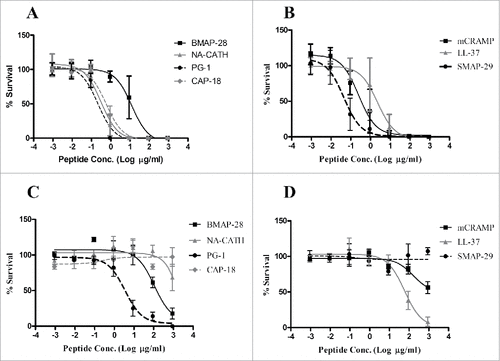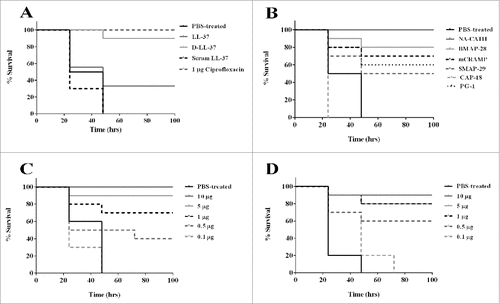Figures & data
Figure 1. Antimicrobial peptides exert activity against vegetative bacilli and endospores. B. anthracis Sterne bacilli (A, B) or spores (C, D) were incubated for 3 h with a range of the log10 peptide concentrations in 10 mM phosphate buffer and percent (%) survival was determined (EC50). Standard deviations of the mean are shown on each graph as error bars.

Table 1. Activity of Antimicrobial peptides against vegetative B. anthracis. Antibacterial and Sporicidal activity of CAMPs against B. anthracis Sterne strain vegetative activity.
Figure 2. Antimicrobial peptide treatment of B. anthracis Sterne spore challenge of G. mellonella. Galleria mellonella survival curve was performed for B. anthracis Sterne spore infected waxworms and treated with (A) LL-37, D-LL-37 and scrambled LL-37; (B) PBS-treated, NA-CATH, BMAP-28, mCRAMP, SMAP-29, CAP-18 and PG-1; (C) dose dependence in NA-CATH and (D) dose dependence in D-LL-37. Significant rescue was observed for all peptides except CAP-18 and scrambled LL-37 while NA-CATH and D-LL-37 had survival that was statistically similar to that of the antibiotic control ciprofloxacin. For dose dependence, both peptides were able to rescue a portion G. mellonella at peptide concentrations as low as 0.5 µg per larva in 10 µl. NA-CATH was able to rescue a statistically similar number of larvae as ciprofloxacin at 5 µg per larvae while D-LL-37 was able to rescue a statistically similar population as ciprofloxacin with 1 µg per larvae. Kaplan-Meier statistics was performed to determine statistical significance of peptide treated versus PBS treated and p-values are shown in Table S2.

